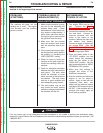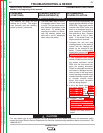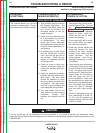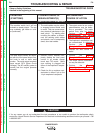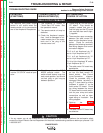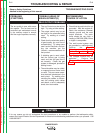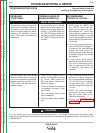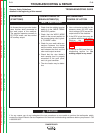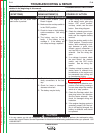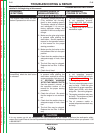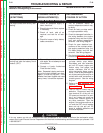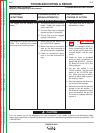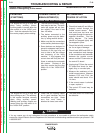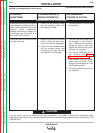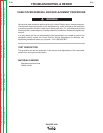
The battery does not stay charged. 1. Check for loose, corroded, or
faulty connections at the bat-
tery.
2. Check for loose or damaged
alternator drive belt.
3. The battery may be faulty.
1. Perform the ENGINE ALTER-
NATOR TEST.
2. There may be a defective com-
ponent or fault wiring, causing a
current draw when the run/stop
switch is in “stop” position.
3. Check the Run/stop switch, the
glow plug button, the alternator
and the starter solenoid. Also
check for damaged wiring and
insulation.
4. If the engine charging system is
operating properly but the bat-
tery is not staying charged, the
battery is defective and should
be replaced.
TROUBLESHOOTING & REPAIR
F-14 F-14
RANGER 305D
Return to Section TOC Return to Section TOC Return to Section TOC Return to Section TOC
Return to Master TOC Return to Master TOC Return to Master TOC Return to Master TOC
If for any reason you do not understand the test procedures or are unable to perform the test/repairs safely,
contact the Lincoln Electric Service Department for electrical troubleshooting assistance before you proceed. Call
1-888-935-3877.
PROBLEMS
(SYMPTOMS)
POSSIBLE AREAS OF
MISADJUSTMENT(S)
RECOMMENDED
COURSE OF ACTION
ENGINE AND IDLE PROBLEMS
The engine will not crank when
start button is pushed.
1. Check circuit breaker (CB7).
Reset if tripped.
2. Make sure the run/stop switch is
in the “RUN” position.
3. Check for loose or faulty battery
cable connections. See wiring
diagram.
4. The battery may be low or
faulty. If the battery is low,
recharge it. If the battery will
not accept a charge, replace it.
1. Check wiring and connections
at the starter motor, glow plug
button. CB7 circuit breaker.
run/stop switch, and the start
button. See wiring diagram.
2. Check the chassis ground con-
nections between the engine
block and the negative battery
terminal.
3. Place the run/stop switch to the
“RUN” position. Press the start
button, while checking for volt-
age between a good clean
chassis ground connection (-)
and lead #211(+) at the starter
solenoid. See the wiring dia-
gram.
4. If no voltage is present, check
the start button, the run/stop
switch, and the CB7 circuit
breaker. See the wiring dia-
gram.
5. If battery voltage is present, the
starter motor or solenoid may
be defective, or the engine may
be prevented from turning due
to a mechanical failure.
CAUTION
Observe Safety Guidelines
detailed in the beginning of this manual.
TROUBLESHOOTING GUIDE



